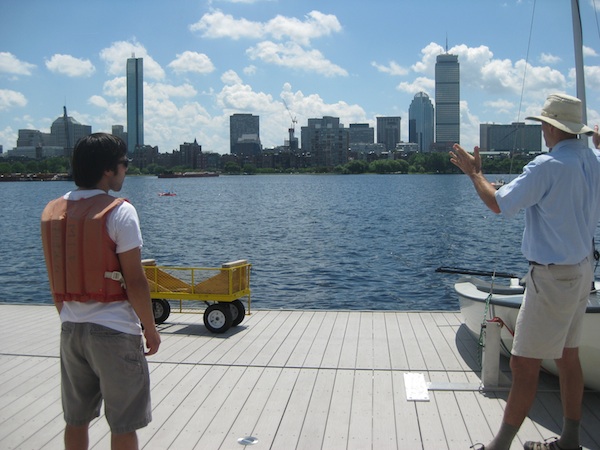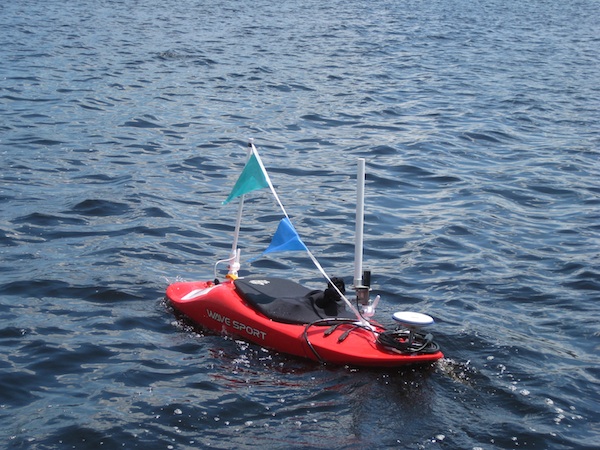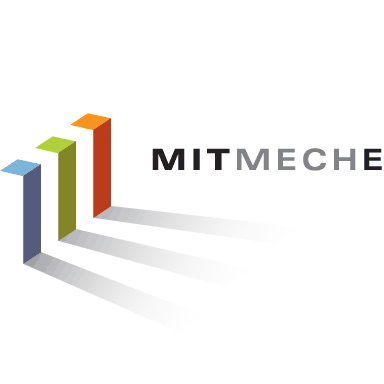Featured Stories | October 5, 2013
Mission TULiP: A Robotic Pursuit on the Charles River
When the MIT Sailing Pavilion was renovated last winter, the Mechanical Engineering Department got access to the refurbished building. “Going into the lab now means jumping off the pier,” says Franz Hover. They filled it with the stuff of their imaginations– underwater robotic vehicles. Now, it’s a test-bed for unmanned ocean exploration with fast, coordinated robot teams.
By Genevieve Wanucha
If you take a stroll past the MIT Sailing Pavilion on Memorial Drive, you may see, among the usual glut of sailboats on the Charles River, two red child-sized kayaks riding the waves. Instead of the 80-pound human they are each designed to hold, the kayaks carry an array of electronics and a pull along a string of plastic flags that flutter in the wind. One is named “Silvana,” the other “Nostromo,” and together they are following close behind “Icarus,” a motorboat. It is a mission of pursuit.

These baby kayaks star in robotic control systems research led by Franz Hover, Associate Professor of Mechanical Engineering at MIT and graduate student Brooks Reed and colleagues, which was just accepted into the International Symposium on Robotics Research (ISRR).
In the Hover Group’s workspace in the sailing pavilion, sheltered from the blaring sun, Reed is monitoring real-time data streaming in from the GPS mounted on the kayaks. He only has to glance to his right to see Silvana and Nostromo at work on the river.
Each of the kayaks tow an acoustic WHOI Micro-Modem, at a depth of about 1.5 meters. Icarus, the target vehicle, sends out a pulse of sound, called a “ranging ping.” Silvana and Nostromo receive it and calculate the the ping’s travel time. By dividing that number by the speed of sound in water, they can compute their own distances from Icarus. Then, they coordinate. Each swap their own location measurements and control actions by sending data packets to each other using the modems. And voila, the pursuers know where to go next. The pair achieve their joint goal of maintaining a tight triangular formation relative to the position of Icarus, tracking their target even as it turns in unpredictable loops.
This shallow-water pursuit scenario is a simple one, but it’s an experimental platform for a highly complex engineering endeavor of which scientists can only dream—using autonomous underwater vehicles (AUVs) to track fast or ephemeral undersea phenomena whose boundaries and trajectories shift in time and space, for example, an oil spill as it meanders downstream, a toxic algae bloom as it forms, a swirling school of fish, a salinity front, or the waters near the edge of a calving glacier.
“Imagine having vehicles that can operate in these kinds of dynamic environments,” says Hover. “That’s what we are after.”

Capturing the details of quickly evolving ocean features is not a job for which individual AUVs qualify. On their own, AUVs get partial or long outdated information if the target is moving faster than the tracking robot. So, the Hover Group’s long-term vision hinges on designing control systems for fast vehicles that work together by communicating via acoustics.
But communicating underwater is a challenge, especially in the shallow waters of the Charles.
When sound propagates through the water, it bounces off the surface, river bottom, and Memorial Drive’s sea walls, creating echoes in the signal. Many times, data packets get lost along the way. Essentially, Reed must design a control system that knows it won’t be dealing with very precise information. “But part of why we choose to do tests here in the Charles River is that it is one of the most difficult communication environments you can find,” he says. “If we can make a system work here, it’s much more likely it will work in a place that has better acoustic communications performance.”
Because Hover and his team, fundamentally a control system design group, are not specialists in the fine arts of acoustics, they collaborate with Milica Stojanovic, Professor at Northeastern University in the Department of Electrical and Computer Engineering, a leader in digital communication networks. She’s a key contributor to the ongoing development of the acoustic modem used on the Hover kayaks, the WHOI Micro-Modem, which grew out of her PhD research 20 years ago. In her work with the Hover Group, Stojanovic helps improve the speed and reliability of signal processing between the vehicles. “That’s where we come together,” she says, “in closing the control loop in the presence of unreliable communications. That’s the beauty of the interdisciplinary project.”

Following on the successful mission with the autonomous kayaks, Reed is now leveraging established numerical ocean models to better design controllers. Ultimately, feeding an ocean model’s forecasting of circulation patterns into a vehicle control system would help guide the vehicles to the most useful or advantageous position for monitoring an ocean feature, such as a algae bloom’s boundary.
TULiP, or Team Underwater Localization and Pursuit of 2013, was born to prove a point. “The whole reason we did this experiment was that we noticed that there was very little work involving truly dynamic pursuit problems in the ocean,” says Reed. That’s partly because it’s commonly argued that acoustics are simply too unreliable to build a whole ocean observation mission around. “But we said, why not? It should be do-able. They aren’t that bad,” says Reed. So the Hover Group purposefully designed a very difficult mission that would never be accomplished without good control system design and principled use of acoustic communications. “And then the experiments worked.”








